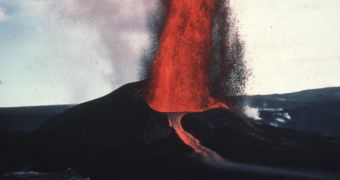Measuring noise levels and composition right before a volcano erupts is a very tricky and risky business, mostly because the scientists have to work on the slopes of the mountain themselves, as they cannot leave the equipment behind, and then recover it later. The reason for that is pretty obvious – the sound receiver would be covered by a thick layer of solidified lava. However, one team of researchers has managed to do this, and its recordings show a very interesting result – the volcano sounds like a jet.
That is to say, the low-frequency noises that make it through from the chamber of the volcano to the surface are very similar in composition to those created by a jet engine when it's turned on. University of California in San Diego (UCSD) expert Robin Matoza has been behind the new study and has managed to get his team as close as 13 kilometers to numerous volcanoes around the globe. Although it may appear a good deal of distance, that's actually very close to the crater, as evidenced by the accuracy of the readings.
They have measured infrasonic signals coming from the underground, and then have played them back a bit faster, so as to enter the range of human hearing. All have been surprised to hear that the distribution of the frequencies within the sounds is nearly identical to that coming from the engines of a Boeing 747 jumbo jet. “The science of jet noise is very well understood. If we can understand how this works for volcanoes, we may be able to infer properties of eruption columns,” Matoza says.
Aeronautics experts know that the noise of a jet comes mostly from the turbulent air that passes by the inner walls of the engine. Because the same thing happens in volcanoes, the research team has concluded that the roar of an eruption is partially generated by ash and gases blasting up and creating turbulences on the inner side of the volcano's crater or mouth.
“This information about the internal dynamics of the plume then helps us understand more about how plumes work. The more we understand about how plumes work, the better we are at mitigating volcanic hazards. If you get a big jet noise like this, it's a very strong indication that a volcano eruption definitely has occurred,” Stanford University expert Darcy Ogden adds.

 14 DAY TRIAL //
14 DAY TRIAL //